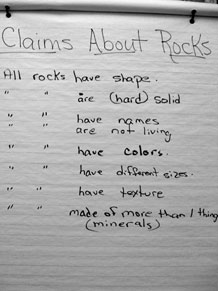What can we learn about rocks by observing them carefully?
4. Make meaning
Purpose of the discussion
The purpose of the discussion is to elicit claims about rocks that can be supported by students‘ observations of four kinds of rock. Focus the discussion on the investigation question.
Engage students in the focus question
Revisit the investigation question:
What can we learn about rocks by observing them carefully?

Ask students to look at the class data and think about what they can say about all the rocks on the list, not just one kind. The goal is to move from observations about individual rocks to general statements — or claims — about all four rocks.
Take observations one at a time and see if they are generalizable. For example:
You observed that basalt is black. But are all rocks black? Some of you observed rocks with other colors. What can we say about color that is true for all of these rock samples?
After eliciting ideas, try for consensus:
Can we agree on this statement: Rocks can be different colors, including gray, white, red, and black?
Create a new class chart: Claims About Our Rocks.
What is a claim? A claim is a statement that is believed to be true, but not proven to be true, and that is based on observations or data. When someone makes a claim, they should be prepared to identify the data on which they base it. As you develop the class list of claims, pause periodically and ask: “What evidence do we have to support this claim?”
Based on our observations of granite, basalt, conglomerate, and sandstone, what else can we claim about rocks?
Continue the discussion until the class has agreed on six or eight statements that hold true for all four rocks. Point out that while the claims may be true for these four rocks, they may not be true for every rock in the world.
Summarize the discussion
Refer to the Claims About Our Rocks chart.
Explain that the materials that make up rocks are called minerals. Let the students know there are thousands of different minerals on Earth, and that quartz is one of the common ones.
Distribute a piece of quartz to each group.
- Is there any of the mineral quartz in your rock?
- What properties does the quartz have that the rest of the rock doesn’t have?
As you recap the investigation, check for understanding of these two points:
- Rocks are objects made of materials called minerals
- Rocks and minerals have observable properties
There is a notebook page for students to record the class's claim about rocks. [Properties of rocks]



